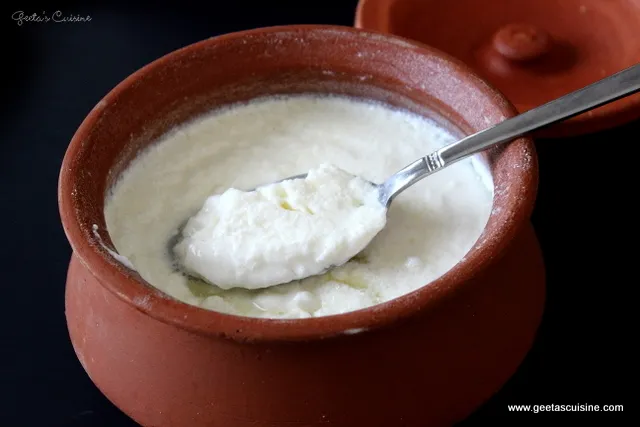Yogurt is a central ingredient in the Indian diet.
As my father worked closely with the Indian Air Force leaders, my parents would be invited to parties on their bases in town. After the party ended, my mother would, infamously, come home and have yogurt rice! A sign of how so deeply embedded yogurt is in the culture and the cuisine.
Naturally, Yogurt remains a central part of our diet even in the US. It is used to make a Punjabi Khadi, an Andhra Daddojanam, or the more famous lassi. But, there is a challenge—The yogurt commercially available in most American grocery stores has two significant flaws from the Indian culinary perspective. First, it often has gelatin in it. Second, it tends to be gooey. So, homemade yogurt is the only viable choice for the connoisseur.
The responsibility to keep the house stocked with yogurt is one of the few culinary responsibilities Surekha trusts me with.  Having made it over the years, I thought that I would share my recipe for all to use. (If Prasad can make it, then ….)
Having made it over the years, I thought that I would share my recipe for all to use. (If Prasad can make it, then ….)
Enjoy!
The Yogurt Recipe
- Rinse a dish with a heavy bottom. Leave a think coat of water at the base.
- Pour a half gallon of milk into the dish.
- Boil it on LOW heat for 30 odd minutes till there is a layer of cream on the surface.
- If you go with a higher flame, you run into two issues. First, the risk of burning the milk. Second, cleaning the dish is a chore; a thick, hard-to-remove layer forms on the bottom.
- Set aside to cool some.
- But not too cool. More on this to follow
- If you are in a cold climate, turn on the oven and set it to 200F.
- In an oven safe dish, beat some yogurt culture with a touch of water.
- The volume of yogurt is about 5-10% of the volume of milk. You can tune it with some experimentation depending on the ambient temperature, pressure, humidity etc in your home
- When the milk has cooled to, say, 200F, pour the milk into the glass dish with the beaten yogurt.
- Try to keep the cream layer intact
- Wait for 30 mins to let it cool
- Stick the glass dish in a microwave and warm for 90 seconds
- Run a spoon on the bottom, mixing the yogurt and milk as best you can
- Turn off the oven, stick the glass container with milk and yogurt into it, close the door and let it stay overnight.
- You can leave the electric light on inside as that generates enough heat to keep the oven warm.
This is a very scientific experiment! So, iterating it to perfection is the only path to success. 😉
There is, however, one MAIN pitfall to worry about. The most important process step is to get the temperature of the milk just right at the time you mix milk and yogurt. If it is too cold, it will not set. If it is too hot, it will destroy the bacteria in the yogurt culture.
I hope that you enjoy your lassi, kadhi or daddojanam!
PS: Sometimes, the yogurt does not set. If this happens, go back and gently add another 5% of the milk’s volume to the yet-to-set yogurt. Poke holes in setting yogurt if on the firm side and gently beat it if on the milky side. In either case, turn the oven back up to 200F, let the yogurt sit in it for an hour, and then let it set.
PPS: “Mishti doi”, the Bengali yogurt sweet, is absolutely to die for. It’s one of my favorite desserts. Don’t miss it if you are ever in Calcutta or Bangalore! (KC Das on Chowringhee Square in Calcutta and on Church Street in Bangalore come to mind.)
PPPS: Thanks to Ramana and Ratna for helping me figure out how not to blow up microwaves and dishes (The trick: Low heat!)










